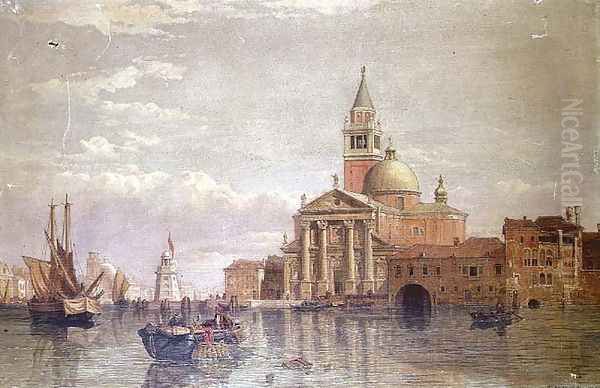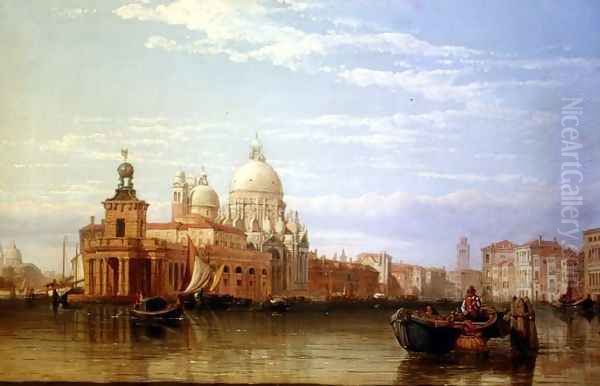Introduction: A Legacy in Landscape
George Clarkson Stanfield, born in London on May 1, 1828, stands as a notable figure in the rich tapestry of British Victorian art. As a painter, he dedicated his career primarily to capturing the diverse landscapes and cityscapes of Europe, alongside the coastal scenes of his native Britain. His life and work were intrinsically linked to his father, William Clarkson Stanfield, one of the most celebrated marine painters and theatrical scene designers of the era. While George forged his own path, the influence of his father, both in training and artistic inclination, remained a defining characteristic of his journey. He became particularly renowned for his detailed and evocative views of Italy, Switzerland, France, and Germany, establishing a reputation for topographical accuracy and atmospheric sensitivity.
Early Life and Artistic Foundations
George Clarkson Stanfield's entry into the world of art was perhaps inevitable, given his parentage. His father, William Clarkson Stanfield (1793-1867), was already a prominent Royal Academician, admired for his dramatic sea paintings and spectacular stage sets. Growing up in this environment provided George with unparalleled access to artistic practice and discussion. Before fully committing to art, however, he experienced life beyond the studio. He briefly served in the British Merchant Navy, an experience that likely deepened his understanding of the sea and ships, subjects often featured in his later work. However, due to health reasons, his maritime career was cut short, prompting him to return to London and focus entirely on painting. His primary artistic education came directly from his father, absorbing techniques and approaches that emphasized careful observation, skilled draughtsmanship, and an understanding of light and atmosphere, particularly in relation to water and architecture.
An Exhibiting Artist: The Royal Academy and Beyond

Following in his father's footsteps, George Clarkson Stanfield sought recognition through established channels. He began exhibiting his works at a remarkably young age, making his debut at the prestigious Royal Academy of Arts in London in 1844, when he was just sixteen years old. This marked the beginning of a long association with the Academy, where he would continue to show his paintings regularly until 1876, two years before his death. He also exhibited at other venues, including the British Institution. His exhibited works showcased his developing talent and his growing fascination with continental European scenery, subjects that were increasingly popular with the British art-buying public, who often undertook the 'Grand Tour' or similar travels.
Travels Across Europe: The Source of Inspiration
Much of George Clarkson Stanfield's subject matter was drawn from his extensive travels across Europe. He journeyed frequently, sketchbook in hand, capturing the distinctive character of various regions. Italy held a particular allure, with Venice and the Italian Lakes featuring prominently in his oeuvre. Switzerland's dramatic alpine landscapes and picturesque lakes also provided rich material. He explored the river valleys of France and Germany, paying special attention to the Rhine and Moselle rivers, documenting the castles, towns, and natural beauty along their banks. Belgium, too, appeared in his work, as seen in his depictions of towns like Dinant. These travels provided the raw material for the detailed and evocative paintings he would later complete in his studio, catering to a Victorian audience fascinated by foreign lands.
Artistic Style: Detail, Light, and Topography
George Clarkson Stanfield's artistic style is characterized by its meticulous attention to detail and topographical accuracy. Working primarily in oils and occasionally watercolour, he rendered buildings, landscapes, and maritime elements with considerable precision. His approach was largely rooted in the realist traditions prevalent in the mid-19th century. He possessed a keen eye for the effects of light and atmosphere, particularly the way light interacted with water and architecture, lending his scenes a sense of immediacy and place. While influenced by his father's broader, often more dramatic style, George's work sometimes exhibits a tighter handling and a greater emphasis on intricate detail. His compositions are typically well-structured, leading the viewer's eye through the scene effectively. His detailed approach echoed the work of earlier topographical artists like Samuel Prout, but with the richer palette and atmospheric concerns of Victorian oil painting.
Representative Works: Capturing Europe's Charm

Several paintings stand out as representative of George Clarkson Stanfield's focus and skill. His View of Dinant, Belgium exemplifies his ability to capture the picturesque quality of European towns nestled within their landscapes. Works depicting Italian scenes, such as San Giorgio Maggiore, Venice, showcase his fascination with the city's unique architecture and waterways, a subject beloved by many artists before him, including Canaletto and J.M.W. Turner. His View on the Lake of Lugano reflects his engagement with the serene beauty of the Swiss-Italian lake district. Furthermore, his painting View of Limburg an der Lahn gained wider recognition when it was featured on a German postage stamp, attesting to its detailed accuracy and appealing composition. Another notable work, Ideal Rhine Landscape (Ideal Rheins Landschaft), demonstrates his ability to synthesize observed details into a harmonious and evocative river scene, capturing the romantic spirit associated with the Rhine Valley.
Continental Focus: The Rhine, Moselle, and Italian Lakes
Stanfield carved a niche for himself with his persistent focus on continental European subjects, distinguishing him somewhat from contemporaries who might have concentrated more on British scenery. The Rhine River, with its dramatic gorges, medieval castles, and bustling river traffic, was a recurring theme. He painted numerous views along its course, as well as along the Moselle. His Italian scenes extended beyond Venice to include views of Lake Como and Lake Maggiore, capturing the interplay of mountains, water, and picturesque villas. Similarly, his Swiss works often depicted the tranquil beauty of Lake Geneva or the dramatic vistas of the Alps. This specialization made his work highly sought after by collectors who had travelled to these locations or dreamed of doing so. His paintings served as visual souvenirs and idealized representations of popular tourist destinations.
A Father's Footsteps: Work for the Stage
Like his father William, George Clarkson Stanfield also ventured into the world of theatrical design, although on a smaller scale. William Clarkson Stanfield had achieved immense fame for his spectacular moving dioramas and pantomime scenery at theatres like the Theatre Royal, Drury Lane. George followed suit, contributing designs for stage productions in London. This work required a different set of skills, involving large-scale execution and the creation of dramatic effects intended to be viewed from a distance under artificial light. His experience in landscape and architectural painting would have been invaluable for creating convincing backdrops and settings. He is known to have collaborated with his father's friend and fellow artist David Roberts on scenic projects, particularly during their time working at the Royal Coburg Theatre and later Drury Lane, continuing a family tradition of bridging the gap between fine art and popular entertainment.
Artistic Circle: Friends and Contemporaries
George Clarkson Stanfield moved within a vibrant artistic and literary circle, largely inherited from his father. His father, William Clarkson Stanfield, was naturally the most significant figure, serving as mentor and benchmark. A notable friendship existed with the great novelist Charles Dickens. Records show Dickens visiting the Stanfield home, and George visiting Dickens. Dickens admired the elder Stanfield immensely, famously dubbing him the "Vandervelde of England" (referencing the Dutch marine masters Willem van de Velde, Elder and Younger), indicating the high esteem in which the family's artistic talents were held.
In the broader art world, GCS worked alongside contemporaries who shaped the Victorian art scene. He was inevitably compared to the towering figure of J.M.W. Turner, especially in the realm of marine painting, though Stanfield's style was generally more literal and less experimental than Turner's later work. His friendship and collaboration with David Roberts, himself a renowned painter of architectural and topographical views, particularly of the Near East and Europe, highlights their shared interests in depicting specific locales. Other landscape and marine painters active during his time included figures like Edward William Cooke, known for his meticulous coastal scenes, Augustus Wall Callcott, and the popular watercolourist Myles Birket Foster. The legacy of earlier landscape masters like John Constable and Richard Parkes Bonington (who had influenced his father) also formed part of the artistic backdrop against which George Stanfield worked.
The Shadow of Fame: Confusion and Attribution
Living and working under the shadow of a famous father presented unique challenges for George Clarkson Stanfield. The similarity in their names (George Clarkson Stanfield vs. William Clarkson Stanfield) and their shared interest in marine and landscape subjects inevitably led to confusion, both during their lifetimes and subsequently in art historical records and the art market. Works by George have sometimes been misattributed to his more famous father, potentially obscuring the son's individual contribution and market value.
An illustrative anecdote involves the Victoria and Albert Museum (formerly the South Kensington Museum). The museum once catalogued a watercolour of the Temple of Sardis by George Clarkson Stanfield, mistakenly stating it was based on a sketch by a "Mr. Maude," who seemingly did not exist in that context. The museum later corrected this error, acknowledging the confusion that could arise. This persistent issue highlights the difficulty George faced in establishing a completely distinct artistic identity, despite producing a substantial body of competent and often beautiful work. While he benefited from his father's connections and training, the comparison was a constant factor in his career.
Later Years and Legacy
George Clarkson Stanfield continued to paint and exhibit throughout the 1860s and into the 1870s. His works remained popular for their faithful depictions of beloved European scenery. He maintained his detailed style, providing a contrast to newer artistic movements like Impressionism that were beginning to emerge across the Channel. His health, which had curtailed his early maritime career, may have continued to be a factor in his later life. He passed away relatively young, at the age of 49, on March 22, 1878, in Hampstead, London.
His legacy is that of a skilled and diligent landscape and marine painter who excelled in the topographical tradition. While not reaching the heights of fame achieved by his father or contemporaries like Turner, George Clarkson Stanfield produced a significant body of work appreciated for its craftsmanship, detail, and evocative portrayal of specific locations. His paintings offer valuable visual records of 19th-century Europe and remain appealing for their clarity and charm. He successfully carried on the Stanfield family's artistic tradition, contributing his own distinct views of the world to the rich panorama of Victorian art. His works are held in various public collections, including the Victoria and Albert Museum and regional galleries in the UK, ensuring his contribution is not entirely overshadowed by his father's considerable reputation.